Experiments and Numeric Simulation on Displacement and Flushing of Hydrocarbon Fluid in Subsea Systems
Abstract
With the increasing number of subsea developments in the oil and gas industry, there is a need for more, and reliable, information on how to conduct safe and well informed subsea operations. One of the hot topics today is displacement of hydrocarbons during shut-in situations and interventions. This is done by injecting a displacement liquid, typically MEG or methanol, to lower the content of hydrocarbons in the domain, aiming to prevent formation of hydrates or release of chemicals that pose a risk to the environment. This report presents results obtained from experimental work and numerical simulations conducted on a U-shaped subsea jumper like pipe setup, performed to analyze how the shape of the displacement front, flow pattern and phase hold up evolves with varying displacement velocity. To examine the accuracy of the numerical model and provide more details about the multiphase flow dynamics, experimental and simulated results were compared.A pipe geometry was designed and constructed to mimic a U-shaped subsea jumper, using 153.6mm inner diameter (ID) transparent PVC pipes. Displacement was done through two different inlets, located at the bottom left and top of the U. When displacing trough the bottom inlet, parts of the closest vertical section were blocked to mimic a dead-leg. In total eight experiments were conducted through each inlet, with water-oil displacement and oil-water displacement with four different velocities. Liquid hold-up was measured after displacing one, two and tree jumper volumes. A high-speed camera was used to capture the flow for further analysis.The experimental cases were recreated and simulated using ANSYS CFX, a computational fluid dynamics simulation (CFD) tool, to check the accuracy of the solver and models used. Two different multiphase models were tested, inhomogeneous mixture model and homogenous standard free-surface model. Shear Stress Transport model was used to model turbulence for both models. Results are reported numerically and visually before being compare to experimental results.Experimental results show that the displacement efficiency is dependent on the establishment of a displacement front. A clear displacement front was only observed for rates higher than 20 m3/h with water-oil and oil-water displacement. Water-oil displacement had the highest displacement efficiency, although it was severely reduced after one displacement volume. Oil-water displacement shows a better displacement efficiency after one displacement volume, but has a lower sweep efficiency due to a reduced front height. Overall the numerical simulations results has problems predicting displacement with low velocities, for oil-water and water-oil displacement. The inhomogeneous mixture model has a better prediction of hold-up for oil-water displacement when there is mixing of the liquids. The homogenous free-surface model predicts best for water-oil displacement, when there are clear interfaces between the liquids.
